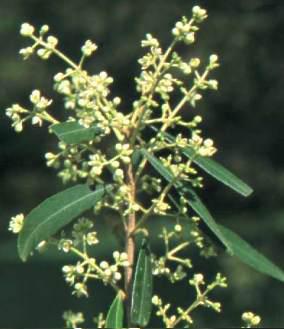Nuxia oppositifolia
Nuxia oppositifolia (Hochst.) Benth.
Family: Stilbaceae
Common names: water elder, bush nuxia (English); watervlier (Afrikaans); iNkhweza (Zulu)
SA Tree No: 635
Introduction
Nuxia oppositifolia is an evergreen shrub or small tree (2-5 m) found along water courses, in riverine bush, in gorges or valleys, and sometimes in relict (existing due to past climatic factors) subtropical forests. It also sometimes grows in between rocks in the actual riverbed. It has a slender, elegant shape with thin, slightly weeping branches.

Description
Description
The water elder is often multistemmed. Unlike other members of the genus, the leaves are opposite, instead of whorled. The leaves are long and narrow and may be entire or slightly toothed in the upper half of the leaf. The leaves may also be slightly sticky when young.
The flowers are white, tubular, very small and borne in dense clusters from October to February. The fruit is a small capsule which can be found inside the calyx (January-May). Young branches and stems are four-angled. The bark is textured, reddish to grey-brown and peels in narrow strips. The main stem may be fluted.
Distribution and habitat
Distribution description
The distribution of Nuxia oppositifolia extends from northern KwaZulu-Natal, eastern Mpumalanga and Northern Province into Zimbabwe. It can also be found in the north of Namibia.
Derivation of name and historical aspects
History
The genus name Nuxia is In honour of French amateur botanist, M. de la Nux, from Reunion Island. The specific name, oppositifolia means "opposite leaves".
There are approximately 40 species of Nuxia in Africa, Madagascar and the Mascarene Islands. 5 of these can be found in southern Africa, namely Nuxia congesta, N. floribunda, N. glomerulata, N. gracilis and N. oppositifolia.
Uses
Use
The water elder's reddish-yellow wood is occasionally used for furniture and ornaments. The stems and leaves are browsed by game, and Black Rhino also eat the bark.
Growing Nuxia oppositifolia
Grow
The water elder is not common in cultivation, but it is useful for planting alongside water in the garden. It will also tolerate normal garden conditions, although the stature of the tree will be determined by the amount of water it gets. It is reasonably hardy to frost and is a fast grower under optimal conditions. Nuxia oppositifolia is a valuable asset to a bird garden as it attracts insects, which in turn attract insectivorous birds. It can also be grown in a container and forms an attractive pot specimen. Not much information is available about this plant, but it is likely that it will respond well to pruning and can be used as part of a mixed screen or as a clipped hedge.
Propagate from semi-hardwood cuttings using rooting hormone. Seed will possibly be difficult to obtain but it should be sown in seed trays on a fine seedling mix. Cover lightly and do not allow to dry out. Avoid overhead watering as the seed is fine and will wash away. Instead place the tray in a clean, shallow container of water and allow the water to soak in to the tray from below. Once the surface is wet, remove the tray from the water. Transplant the seedlings once they have formed their true leaves.
References
- Arnold, T.H. and de Wet, B.C. (eds) 1993. Plant Names of Southern Africa: Names and Distribution.. National Botanical Institute. Pretoria.
- Daydon Jackson, B. 1971. A Glossary of Botanic Terms. Gerald Duckworth & Co Ltd. London.
- Palmer, E and Pitman, N. 1972. Trees of Southern Africa: Volume 3. A.A. Balkema. Cape Town.
- Leistner, O.A. (ed.) 2000. Seed Plants of Southern Africa: Families and Genera. Strelitzia 10. National Botanical Institute. Pretoria
- Pooley, E. 1993. The Complete Field Guide to Trees of Natal, Zululand & Transkei. Natal Flora Publications Trust. Durban
- Van Wyk, B and van Wyk, P. 1997. Field Guide to Trees of Southern Africa. Struik Publishers. Cape Town.
Credits
Alice Aubrey
Walter Sisulu National Botanical Garden
February 2002
Plant Attributes:
Plant Type: Tree
SA Distribution: KwaZulu-Natal, Limpopo, Mpumalanga
Soil type: Loam
Flowering season: Spring, Early Summer
PH: Neutral
Flower colour: White
Aspect:
Gardening skill: Average
Special Features:
Horticultural zones








Rate this article
Article well written and informative
Rate this plant
Is this an interesting plant?
Login to add your Comment
Back to topNot registered yet? Click here to register.